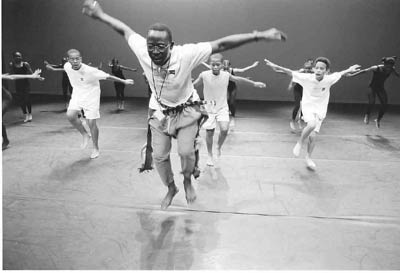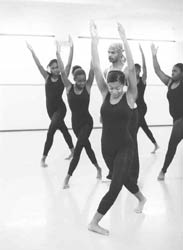 |
| AileyCamp
instructor Khatab Cissokho demonstrates African dance moves
to students. Photos by Peter Dasilva |
AileyCamp helps youth leap over life's obstacles
19 July 2002
By D. Lyn Hunter, Public Affairs
BERKELEY - As a hypnotic African drumbeat echoes across
the empty auditorium, a group of youngsters springs back and
forth across UC Berkeley's Zellerbach stage, their arms and
legs jutting in rhythm to the music.
After several minutes of high-energy dancing, the children
end the piece with a hearty "Hey!" Hands on hips and breathing
heavily, they look to their teacher for feedback.
"Wonderful," says instructor Khatab Cissokho, dressed in a
colorful dashiki. "But I want to see your feet even higher off
the floor." The kids hang their heads and moan in unison, but
when the music starts again, their jumps sparkle with renewed
enthusiasm.
Education through dance
This is another typical day at AileyCamp, where firm coaching
and words of encouragement are doled out in equal doses to 75
students from local middle schools. The six-week camp, founded
by the late dance pioneer Alvin Ailey, targets at-risk youth.
Corporations, foundations, grants and the university cover all
the costs for the campers, including tuition, dance attire,
food and transportation.
Alvin Ailey's philosophy was to develop the whole person, not
just dancers, according to camp director David McCauley, a former
Ailey dancer and company administrator. The camp is built around
this concept. Using instruction in African, jazz, modern and
ballet dance forms — as well as classes on personal development,
performance techniques and creative communication — the
camp seeks to improve the children's self-esteem, discipline
and critical thinking skills.
|
"Putting
it Together"
Thursday, Aug. 1
7 p.m., Zellerbach Hall
After
weeks of intensive study, the campers will show off their new skills at a final performance. Admission
is free; advance tickets are available at the Cal Performances Ticket Office. Call 642-9988 for more information. |
 |
"We target kids at this age because they're in the midst of
finding out who they are," McCauley said. "We try to provide
them with a map to help make these connections."
Hard work, trial and error, and overcoming obstacles are all
part of learning how to dance, he added, and this process is
a wonderful way to prepare children for dealing with other aspects
of life.
The camp is offered in several cities around the country, but
this marks the first time it has been mounted on the West Coast.
Berkeley's Cal Performances series — for which Alvin Ailey
American Dance Theater performs most frequently, outside of
New York City — is hosting the camp.
"When artists come to Zellerbach to perform, there's little
time for them to have an impact on the surrounding community,"
said Hollis Ashby, assistant director of Cal Performances. "With
AileyCamp here for a month and a half, local youth will get
extended exposure to the arts, which we think is crucial to
their future success."
It also helps to have these kids on a college campus everyday,
she said, so they can see Berkeley as a possible destination
after high school.
"I like the campus, it's nice," said camper Lorraine Chaney,
a 13-year-old from Oakland. "Most of the places I've been to
are dirty and people don't seem to care."
Tough art, tough love
As the children on stage continue their African dance moves,
another group is practicing ballet in a studio tucked in the
basement of Zellerbach Hall. The students are diligently working
on their jetés, pliés and glissades, endlessly
repeating the steps to achieve just the right form. Frustrated,
some in the class quit and begin joking and pushing each other
around.
Willie Anderson, the instructor (and a member of Ballet San
Jose), quickly brings the class back to order. "The only one
who should be talking is me," he booms. "If you have something
to say, you must raise your hand."
Anderson's approach may be strict, but it reaps important benefits.
"The discipline of dance teaches many life lessons," he says.
"When something isn't going right, you can't just get mad and
give up. You have to learn how to analyze it and work through
it, one step at a time."
Having been a troubled child, Anderson understands where some
of these kids are coming from and knows they need tough love
in order to succeed.
 |
| Students
perfect their modern dance techniques as instructor Derrick
Minter looks on. |
"I push them hard, but when they finally accomplish something
and a big smile spreads across their face, it's so rewarding,"
Anderson says. "Dance changed my life forever. I hope it has
the same affect on these kids, regardless of whether they become
professional dancers or not."
The camp utilizes local talent like Anderson for instruction
as well as several UC Berkeley students, who serve as team leaders.
The Cal students — all skilled dancers in their own rite
— are a crucial bridge between the often rambunctious youngsters
and progress-driven teachers.
"I try to stay on middle ground. Not too serious, but not too
silly," said Raynelle Gipson, a senior business administration
major and hip-hop specialist. "I spend my days doing a lot of
talking with the campers, helping them work out conflicts with
the teachers and each other."
The kids are at that stage where they constantly test boundaries,
said jazz instructor Frances Rosario-Pott. Combine this with
the enormous amount of rules and regulations associated with
dance, and sparks can fly. "We hold them accountable for their
actions, and I think many of these students are not accustomed
to this," she says. "We have to encourage and push at the same
time, making them understand that they have to work hard to
achieve something significant."
Muscles and tears
While some of the campers get distracted during class, others
are keenly focused on the task at hand, like Jonathan Breland,
a Berkeley eighth grader.
"I like breaking a good sweat and knowing at the end of the
day I did a good job," he says. "I can hold my head high knowing
I've learned something important and can share that with others."
For Chaney, the camp gives her life purpose. "It's fun to get
up in the morning and actually have something to do," she explained.
"If it wasn't for this camp, I'd be at home all day doing nothing,
just sitting on the porch and talking about people."
While the camp offers something different to each participant,
the overall goal is the same: to open the children's eyes to
trying new things, says McCauley.
"When the camp ends, some of the children will be crying because
it's over," he said. "But there will be tears of joy as well,
knowing they worked so hard and succeeded at something they
thought was out of their reach."
|